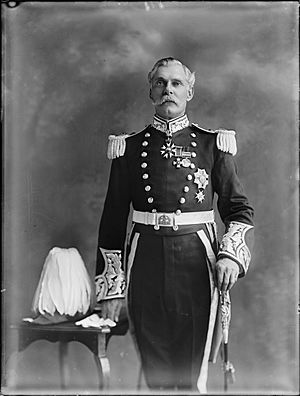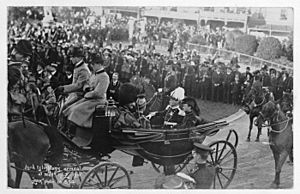John Dickson-Poynder, 1st Baron Islington facts for kids
Quick facts for kids
The Lord Islington
|
|
|---|---|

Lord Islington in 1911.
|
|
| 15th Governor of New Zealand | |
| In office 22 June 1910 – 3 December 1912 |
|
| Monarch | George V |
| Prime Minister | Joseph Ward Thomas Mackenzie William Massey |
| Preceded by | The Lord Plunket |
| Succeeded by | The Earl of Liverpool |
| Personal details | |
| Born | 31 October 1866 Isle of Wight, England |
| Died | 6 December 1936 (aged 70) Hyde Park Gardens, London, England |
| Spouse | Anne Dundas |
| Children | Joan Grigg |
| Relatives | John Grigg (grandson) |
John Poynder Dickson-Poynder, 1st Baron Islington (born 31 October 1866 – died 6 December 1936), was an important British politician. He was also known as Sir John Poynder Dickson-Poynder before 1910. He served as the Governor of New Zealand from 1910 to 1912.
Early Life and Family
John Poynder Dickson-Poynder was born on the Isle of Wight in England. His father was Rear Admiral John Bourmaster Dickson. He went to Twyford School, Harrow, and Christ Church, Oxford for his education.
In 1884, he inherited the title of baronet from his uncle. Later, in 1888, he added "Poynder" to his name. This happened after he inherited property from his mother's side of the family. He made changes to the Poynder family estates in Wiltshire, including Hilmarton and Hartham.
He married Anne Beauclerk Dundas. Her grandfather was Baron Napier of Magdala. They had one daughter named Joan. Joan later became Lady Altrincham and helped organize nursing services in Africa.
Political Career
In 1890, John Dickson-Poynder was appointed High Sheriff of Wiltshire. This was an important local role.
He was first elected as a Conservative Member of Parliament (MP) in 1892. He represented the Chippenham area. An MP is a person elected to represent a group of people in the national parliament.
Later, in 1905, he changed his political party and joined the Liberals. He also served on the London County Council from 1898 to 1904. This council helped manage the city of London. In 1902, he visited British India.
Military Service
Dickson-Poynder started his military career in a volunteer army group called the volunteer battalion of the Royal Scots. He then moved to the Royal Wiltshire Yeomanry, where he became a captain in 1898.
He volunteered to serve in the Second Boer War in South Africa. He was a lieutenant in the Imperial Yeomanry. During his service, he worked as an aide-de-camp (a personal assistant) to Lord Methuen. For his bravery and service, he received the Distinguished Service Order (DSO) award in 1900. In 1902, he was promoted to major in the Royal Wiltshire Yeomanry.
Governor of New Zealand
In 1910, John Dickson-Poynder was appointed Governor of New Zealand. A Governor is a representative of the British monarch in a country. He held this important position for two years.
On 27 April 1910, he was given the title Baron Islington. He was the last person to hold the title of "Governor of New Zealand." After his time, the title was changed to "Governor-General of New Zealand." In 1911, he became a KCMG and a Privy Counsellor.
In 1912, he became the President of the Royal Commission on the Public Services of India. This group looked into how public services worked in India.
Later Public Roles
Before becoming Governor, he was part of the Royal Commission on London Traffic in 1904. He also worked on trade relationships between Canada and the West Indies in 1909.
Later, he became the Under-Secretary of State for the Colonies. In 1915, he became the Under-Secretary of State for India. These roles involved helping to manage British colonies and India.
He also led the Imperial Institute for eight years. From 1920 to 1926, he was in charge of the National Savings Committee. This committee encouraged people to save money. For his many contributions, he was awarded the Knight Grand Cross of the Order of the British Empire (GBE) in 1926. He had received the Knight Grand Cross of the Order of St Michael and St George (GCMG) earlier in 1913.
Death
Lord Islington passed away on 6 December 1936, at the age of 70. He died at Hyde Park Gardens in London. He was buried in Hilmarton, Wiltshire. Since he had no sons, his titles of baron and baronet ended when he died. His wife, Lady Islington, later ran a nursery at Dyrham Park during the Second World War.
Images for kids




